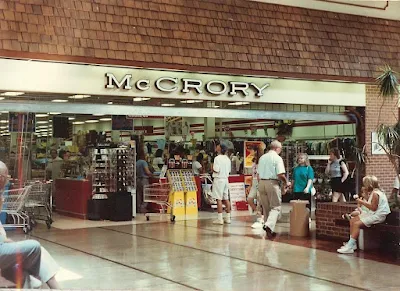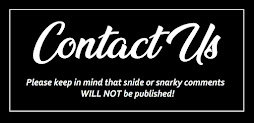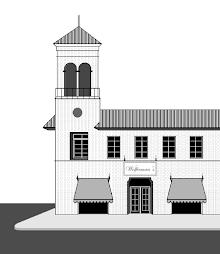The 5 & 10, 5 & dime, dime store or variety store was a 20th century institution in the Forty-Eight States, Hawaii, Alaska, Puerto Rico and the US Virgin Islands. Originating late in the 19th century, a majority of America's 5 & 10 stores started out with locations in Pennsylvania. The Keystone State can lay claim to the development of four major chains; F.W. Woolworth, J.G. McCrory, J.J. Newberry and G.C. Murphy.
5 & 10s, as a whole, survived the Great Depression unscathed. They went on to junior-anchor many an early mall-type shopping center. In fact, America's very first mall, Seattle's NORTHGATE CENTER, featured J.J. Newberry and F.W. Woolworth as two of its charter tenants. The third shopping mall in the nation, Greater Los Angeles' LAKEWOOD CENTER, housed an F.W. Woolworth in its first stage of stores.
By the mid-1960s, the trusty "5 & dime" was a standard feature of an American shopping mall. Often, there would be two stores -of different nameplates- within a single shopping complex. Of course, in that day and age, a shopping mall was conceived and operated as a middle-market, everything in one place place. By the late '70s, the focus had shifted toward a preponderance of fashion and shoe store tenants. The trusty "mall" 5 & 10 began to disappear.
A few established mall 5 & 10 stores would survive into the late 1990s. However, by the turn of the 20th century, the typical mall-based dime store, and the 5 & 10 in general, had been relegated to misty, water-colored memory.
5 & 10s, as a whole, survived the Great Depression unscathed. They went on to junior-anchor many an early mall-type shopping center. In fact, America's very first mall, Seattle's NORTHGATE CENTER, featured J.J. Newberry and F.W. Woolworth as two of its charter tenants. The third shopping mall in the nation, Greater Los Angeles' LAKEWOOD CENTER, housed an F.W. Woolworth in its first stage of stores.
By the mid-1960s, the trusty "5 & dime" was a standard feature of an American shopping mall. Often, there would be two stores -of different nameplates- within a single shopping complex. Of course, in that day and age, a shopping mall was conceived and operated as a middle-market, everything in one place place. By the late '70s, the focus had shifted toward a preponderance of fashion and shoe store tenants. The trusty "mall" 5 & 10 began to disappear.
A few established mall 5 & 10 stores would survive into the late 1990s. However, by the turn of the 20th century, the typical mall-based dime store, and the 5 & 10 in general, had been relegated to misty, water-colored memory.
America's 5 & 10 phenomenon began in 1879. Frank Winfield Woolworth opened his first "Great 5 Cent Store" in Utica, New York, on February 22nd. Although initially successful, the store had a less than desirable location. It closed for good after only 4 months.
Woolworth decided to open a second mercantile in a better location. The second "Great 5 Cent Store," in a busy section of downtown Lancaster, Pennsylvania, commenced operation on June 21, 1879. The store was an astounding -and lasting- success. It was rebannered as the "5 & 10 Cent Store" in the summer of 1880.
A revolutionary retail concept was conceived. Up to this time, the typical mercantile did not display prices along with merchandise. The amount paid for an item could vary from sales clerk to sales clerk or from customer to customer. For the "5 & 10 Cent Store," there was a fixed price prominently displayed. Moreover, the company would purchase directly from the manufacturer.
In August 1910, the first in-store Woolworth restaurant began operation at the chain's 14th Street Manhattan store. Restaurants or lunch counters would eventually be included in nearly every store, with eateries known as Woolworth's Luncheonette, Woolworth's Restaurant or Woolworth's Cafeteria. Post-1961, Woolworth food service facilities would also be known as the Harvest House Coffee Shop or Harvest House Cafeteria.
The first Canadian store had opened -in Toronto, Ontario- in January 1899. In 1912, the American enterprise was incorporated as the F.W. Woolworth Company. There were 631 stores in the United States. By 1919, there were 1,081. During the Second World War, store numbers fluctuated. In 1940, there had been 2,027 (this figure including stores in Canada, Great Britain and Germany). In 1947, this total had dropped to 1,792.
In August 1910, the first in-store Woolworth restaurant began operation at the chain's 14th Street Manhattan store. Restaurants or lunch counters would eventually be included in nearly every store, with eateries known as Woolworth's Luncheonette, Woolworth's Restaurant or Woolworth's Cafeteria. Post-1961, Woolworth food service facilities would also be known as the Harvest House Coffee Shop or Harvest House Cafeteria.
The first Canadian store had opened -in Toronto, Ontario- in January 1899. In 1912, the American enterprise was incorporated as the F.W. Woolworth Company. There were 631 stores in the United States. By 1919, there were 1,081. During the Second World War, store numbers fluctuated. In 1940, there had been 2,027 (this figure including stores in Canada, Great Britain and Germany). In 1947, this total had dropped to 1,792.
The Woolworth variety store count in 1960 stood at 2,075; this figure including only those stores in the United States and Puerto Rico. By 1970, there were 1,927. This figure was comprised only of stores in the United States, Puerto Rico and the US Virgin Islands.
Woolco, a discount department store chain created by the Woolworth Company, opened its first store on June 6, 1962. The large-format "discount mart" concept was successful for a time, but by the early 1980s, had become a liability. The United States Woolco operation went out of business January 31, 1983. Branches in the UK and Canada continued on but were eventually shuttered, as well.
Woolco, a discount department store chain created by the Woolworth Company, opened its first store on June 6, 1962. The large-format "discount mart" concept was successful for a time, but by the early 1980s, had become a liability. The United States Woolco operation went out of business January 31, 1983. Branches in the UK and Canada continued on but were eventually shuttered, as well.
By the late 20th century, there were Woolworth variety-type stores in all of the fifty states, as well as in Puerto Rico, Germany, Great Britain, Ireland, Mexico, Cuba, Spain, Canada, the US Virgin Islands and other areas of the Caribbean. The total number of Woolworth variety stores in the United States in 1976 was 1,503. The total number, in the United States, in 1985 was 1,210.
Regretfully, the 5 & 10 format was becoming outdated by the 1980s. The dime store, with its sometimes esoteric lines of merchandise -and 20,000 to 60,000 square foot footprint- was not able to compete effectively with the likes of a 120,000 square foot, "deep discounting" Kmart, Wal-Mart or Target.
An attempt at corporate restructuring was done by Woolworth in 1993 and 1994, with 400 stores shuttered. This initiative was unsuccessful. On July 17, 1997, the remaining Woolworth stores were shuttered...ending the 100+ year reign of the once-mighty merchandiser. As a result of the dissolution, the corporate name was changed to the Venator Group...which morphed into Foot Locker, Incorporated...in 2001.
WOOLWORTH JUNIOR-ANCHORED SHOPPING MALLS:
*RIVER ROADS CENTER, Jennings, MO (1962)
*WEST SHORE PLAZA SHOPPING CITY, Tampa, FL (1967)
*CENTRAL CITY MALL, San Bernardino, CA (1972)
Something New, indeed. A contemporary write-up in a Lancaster, Pennsylvania newspaper makes mention of the "5-cent store" recently opened by F. W. Woolworth.
Advert from the Lancaster Examiner, July 9, 1879
Photo from F.W. Woolworth Company Annual Report 1979
Mr. Woolworth built the 792-foot Woolworth Building in New York City and paid 13.5 million dollars for its construction in cash. At the time of its completion, in April 1913, the so-called "Cathedral of Commerce" was the world's tallest building; a title held until 1930.
Photo from the Internet Archive
A 1930s-vintage postcard depicts the Woolworth store in Portland, Maine.
Graphic from the Boston Public Library
The standard Woolworth store nameplate of the 1940s.
Graphic from F. W. Woolworth Company Annual Report 1945
Graphic from F. W. Woolworth Company Annual Report 1950
This ultra-modern nameplate and logo was introduced in the late '60s.
Graphic from F.W. Woolworth Company Annual Report 1968
This design commemorated the 100th Anniversary of the chain.
Graphic from F.W. Woolworth Company Annual Report 1979
The downtown Seattle store opened for business in 1940.
Photo from the F.W. Woolworth Company Annual Report 1946
A depiction of the famous Woolworth Luncheonette.
Drawing from the F.W. Woolworth Company Annual Report 1940
A typical meal special at the Luncheonette sold for just 25 cents in 1940.
Graphic from the F.W. Woolworth Company Annual Report 1940
Always on the cutting edge, Woolworth opened a store at America's first shopping mall. The NORTHGATE CENTER store, north of Seattle, was dedicated in November 1950.
Photo from F.W. Woolworth Company Annual Report 1950
Woolworth also established a store at another iconic American mall. The SOUTHDALE CENTER store, in Edina, Minnesota, opened its doors in October 1956.
Photo from http://www.mnhs.org / Minnesota Historical Society
The downtown Omaha Woolworth opened in 1962. It encompassed 107,000 square feet on 5 levels and was the largest variety store in the chain.
Photo from F.W. Woolworth Company Annual Report 1962
Photo from F.W. Woolworth Company Annual Report 1963
During the mid-20th century years, the Woolworth Company was the largest prepared food retailer in the world. Nearly all stores had a "Woolworth Luncheonette." In late 1961, Woolworth's introduced the Harvest House Cafeteria chain. These restaurants were usually built as part of a Woolworth store, although a few were freestanding and located in another part of a shopping center or mall.
Drawing from the F.W. Woolworth Company
The Woolworth at Lancaster, Pennsylvania's PARK CITY CENTER opened in September 1971. It was only a few miles from the very first Woolworth 5 & 10 store.
Photo from F.W. Woolworth Company Annual Report 1972
A Woolworth variety store was an anchor at MESABI MALL in Hibbing, Minnesota. The shopping hub and Woolworth were officially dedicated in August 1971.
Photo from Gallagher's Studio of Photography
Photos from F. W. Woolworth Annual Report 1972
We now take a short tour of a Woolworth variety store of the mid-1960s. Above, we see the Sewing Center.
Photo from F.W. Woolworth Company Annual Report 1964
The Bedding Department is next...
Photo from F.W. Woolworth Company Annual Report 1964
Followed by the Books Department.
Photo from F.W. Woolworth Company Annual Report 1964
Paints & Hardware is seen here.
Photo from F.W. Woolworth Company Annual Report 1964
Our next stop will be the Record Department.
Photo from F.W. Woolworth Company Annual Report 1964
Shoppers peruse the Boys & Men's Shop in this vintage image.
Photo from F.W. Woolworth Company Annual Report 1964
Lastly, what would have been the favorite department of any Baby Boomer, the Woolworth's Toyland.
Photo from F.W. Woolworth Company Annual Report 1964
The Woolworth name became known around the world. Divisions were established in Canada (1897), Great Britain (1909), Ireland (1914), Cuba (1920), Germany (1927), Mexico (1956) and Spain (1967).
In 1965, Woolworth operated 278 retail stores in Canada, 1,119 in Great Britain, 118 in West Germany and West Berlin and 10 in Mexico. The first store in Spain was dedicated in December 1967.
Graphic from F.W. Woolworth Company Annual Report 1969
Graphic from www.woolworths.co.uk
Graphic from www.woolworth.de
Graphic from www.woolworths.com.au
Drawing from J.A. Albertson / Alsco, Incorporated
The WEST PARK PLAZA Sears opened in May 1961. It comprised 1 level and 75,400 square feet; this figure taking in the freestanding Sears Auto Center (which is seen on the right).
Drawing from J.A. Albertson / Alsco, Incorporated
S.S. Kresge also opened their single-level WEST PARK PLAZA store in May 1961. It was the 769th unit in the Michigan-based 5 & 10 chain.
Advert from the S.S. Kresge Company
The McCrory Stores Corporation was established. In 1946, it operated 199 stores, with the total rising to 213 by 1956. The company carried out an ambitious program of dime store chain acquisitions. On January 30, 1959, units in the McLellan Stores chain were taken under the McCrory umbrella. Stores in the H.L. Green chain merged with McCrory on March 10, 1961. A new corporate division, known as "MMG" (McCrory-McLellan-Green), was created.
Meanwhile, the McCrory Stores enterprise had been engulfed by the Rapid American Corporation, of New York, New York, on July 16, 1960. The official moniker of the variety store chain of 445 units was now the McCrory Corporation. By 1966, the store count had climbed to 559. The 439-store J.J. Newberry chain was absorbed in September 1972. There were 837 McCrory-McLellans-H.L. Green and Newberrys stores by 1976.
Chain store acquisitions continued. Shuttered W.T. Grant units were bought in the late 1970s. On January 1, 1981, the 66-store S.H. Kress conglomerate was taken in. Various vacant Neisner's stores became McCrory Corporation property. T G & Y 5 & 10s joined the fold in January 1986, with selected S.S. Kresge, Kmart and G.C. Murphy stores purchased between 1987 and 1989. The McCrory enterprise now consisted of 1,300 variety stores in forty-six states.
The economic slump of the 1970s resulted in a loss of commerce for the McCrory Corporation. A downsizing and tightening of efficiency within the organization stabilized the company for a time. However, by the late 1980s, McCrory was, once again, in dire straits. The problems were exacerbated by the somewhat shifty dealings of Meshalum Riklis, who owned Rapid American.
As the 1990s rolled around, 229 out of 1,300 stores had been shuttered; these being operated under the McCrory, G.C. Murphy, T G & Y and J.J. Newberry nameplates. 300 of 460 stores shut down in 1997. By April 2001, the remaining 160 stores had gone out of business, bringing an end to the McCrory Stores story.
McCRORY JUNIOR-ANCHORED SHOPPING MALLS:
*WALT WHITMAN CENTER, Suffolk County, NY (1962)
*THOMAS MALL, Phoenix, AZ (1963)
*DAYTON MALL, Montgomery County, OH (1970)
The first J.G. McCrorey's 5 & 10 Cent Store was in Scottdale, Pennsylvania. The mercantile opened in the fall of 1882.
Photo from the McCrory Stores Corporation Annual Report 1946J.G. McCrory (1860-1943). Legend has it that he had the "e" legally extracted from his surname as a cost-cutting measure. With new stores opening practically every day, the savings incurred from one less letter on the sign added up!
Photo from https://hgsic.wordpress.com / Historical & Genealogical Society of Indiana County, Pennsylvania
Graphic from the McCrory Stores Company
The McCrorys' "5-10-25 cent Store" -in Syracuse, New York- is depicted on this vintage postcard.
Graphic from the Boston Public Library
The interior of a circa-1946 McCrorys.
The McCrorys' "5-10-25 cent Store" -in Syracuse, New York- is depicted on this vintage postcard.
Graphic from the Boston Public Library
The interior of a circa-1946 McCrorys.
Photo from the McCrory Stores Corporation Annual Report 1946
Another 1946 store snapshot.
Photo from the McCrory Stores Corporation Annual Report 1946
The logo for 1946.
Graphic from the McCrory Stores CorporationA corporate trademark from 1953.
Graphic from the McCrory Stores Corporation
A breakdown of the McCrory Corporation from the mid-1960s. By this time, a variety store mega-company is known as MMG (McCrory-McLellan-Green). It operates 566 units. As one can see, the Corporation had a varied portfolio, operating not only MMG but Otasco, Lerner Shops and the S. Klein department store chain of New York.
Graphic from the McCrory Corporation Annual Report 1965
The McLellans chain -of 235 stores- merged with McCrorys on January 30, 1959. The assets and retail stores of H.L. Green Company, Incorporated were added to a new MMG division in March 1961.
Photo 1 from the McCrory Corporation Annual Report 1960
Photo 2 from the McCrory Corporation Annual Report 1961
Photo from "McCrory Stores Former Employees" / Joe Tierney
In September 1972, the McCrory Corporation took over the entire J.J. Newberry (Newberrys) and Britts enterprises.
Photo from the McCrory Corporation Annual Report 1972
Subscribe to:
Posts (Atom)



























































